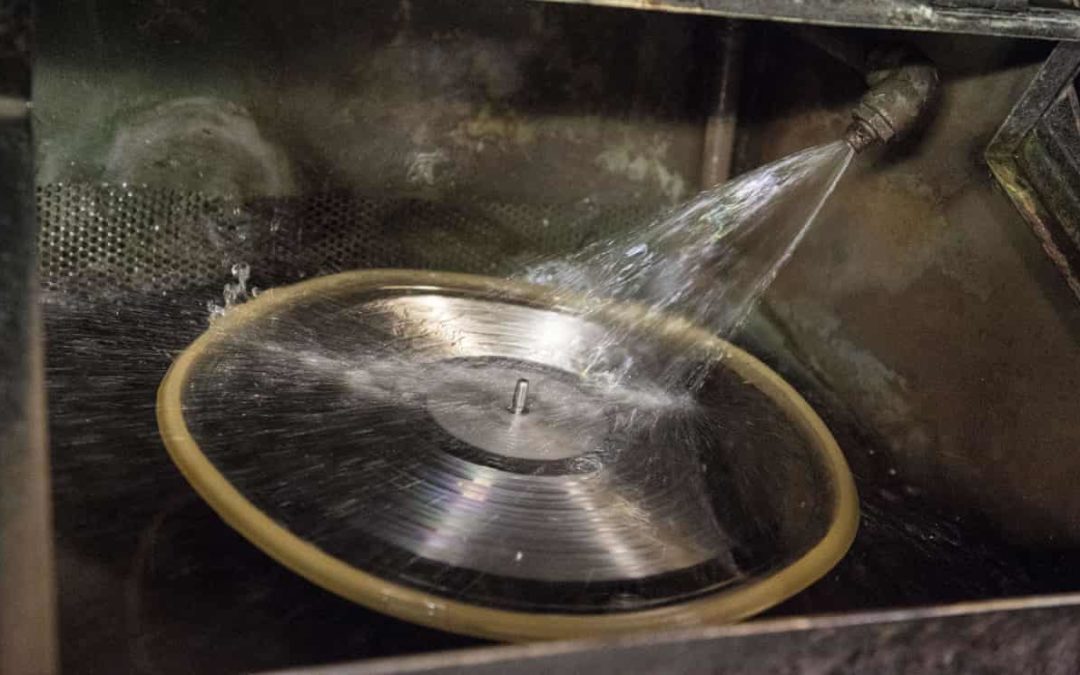SOURCE: The Guardian
DATE: January 28, 2020
SNIP: Inside a US vinyl pressing plant – its owners have asked that I do not give its location – dozens of hydraulic machines run all day and night. These contraptions fill the building, as long as a city block, with hissing and clanking as well as the sweet-and-sour notes of warm grease and melted plastic. They look like relics, because they are. The basic technological principles of record pressing have not changed for a century, and the machines themselves are decades old.
While it is far exceeded by revenues from streaming, the vinyl market keeps growing – Americans now spend as much on vinyl as they do on CDs, while there were 4.3m vinyl sales in the UK last year, the 12th consecutive year of growth. So, if you’re one of the millions of people to re-embrace vinyl records, it’s worth knowing where they come from and how they’re made. There are containers called hoppers at each pressing station, brimming with the lentil-like polymer pellets that get funnelled down into the machinery, heated and fused to form larger biscuits that resemble hockey pucks, and squashed to make records.
Employees are cagey about the separate warehouse where this company stockpiles its plastic. But the empty fridge-sized cardboard boxes on the pressing floor hint at their origin. They are marked with big red letters proclaiming, “Vinyl compound” and “Product of Thailand”.
While vinyl pellets are shipped in large boxes, it takes only a handful to make a typical record. US–based petrochemical corporations supplied much of this raw material until the LP market dried up after 1990 and, consequently, the US supply chain evaporated. Nowadays, with the stylus back in style, the ingredients of LPs are manufactured offshore. More than half of the polyvinyl chloride (PVC) used by today’s US record manufacturers comes from the Thai Plastic and Chemicals Public Company Limited (TPC), which has its headquarters in Bangkok.
Unsurprisingly, security was tight at the TPC facility, and guards refused me at the gate; I never saw inside or had contact with TPC representatives. Instead, a representative from SCG Chemicals – TPC’s parent corporation and one of the largest petrochemical manufacturers in Asia – agreed to meet at my hotel to discuss their business and to explain how vinyl is made.
The process of producing PVC compound is complicated. There are numerous phases, a campus of buildings, tall silos, deep vats, busy machines, as well as many workers in hardhats, hairnets and safety glasses. But the basic principles are easy to imagine.
If you have ever rolled Play-Doh in your hands, placed it in one end of a garlic-press-like gadget and squeezed it out the other, then you know how PVC compound is made. Once PVC has been synthesised from its component chemicals, the raw resin is then mixed with a variety of additives, heated to form a molten plastic compound, forced like spaghetti strands through a die and chopped into pellets.
The SGC representative I met was quick to explain the intricate sciences, the high levels of industrial expertise and the thorough quality-control checks needed to make this high-grade vinyl compound, but stonewalled questions about the harmful side effects of vinyl production. PVC contains carcinogenic chemicals, and the operation produces toxic wastewater that the company has been known to pour into the Chao Phraya River according to Greenpeace, which says TPC has “a history of environmental abuses” going back to the early 1990s.
Vinyl records, as well as cassettes and CDs, are oil products that have been made and destroyed by the billion since the mid-20th century. During the US sales peaks of the LP, cassette and CD, the US recording industry was using almost 60m kilos of plastic a year. Using contemporary averages on greenhouse gas equivalent releases per pound of plastic production, as well as standard weight figures for each of the formats, that is equivalent to more than 140m kilos of greenhouse gas emissions each year, in the US alone. Music, like pretty much everything else, is caught up in petro-capitalism.
Is rejecting physical media and embracing streaming the answer? This is the wrong way of framing the issue, as digital media is physical media, too. Although digital audio files seem virtual, they rely on infrastructures of data storage, processing and transmission that have potentially higher greenhouse gas emissions than the petrochemical plastics used in the production of more obviously physical formats such as LPs – to stream music is to burn coal, uranium and gas.
The amount of energy required to stream an individual song or album is negligible – much less than it takes to get that same music on an LP, cassette or CD – but one-to-one comparisons miss the point. We need to understand the aggregate energy effects of billions of streamers who now expect, without a second thought, instant access to unlimited amounts of music. This culture of listening is what gives us the result that, although the US recording industry is using far less plastic, it is producing more greenhouse gas emissions. Conservative estimates show the amount of such emissions to be 200m kilos a year after 2015, while pessimistic estimates show it to be 350m kilos a year – which is more than double the US industry’s emissions profile at the height of vinyl, cassettes or CDs. Individual digital audio files use less energy than those previous formats. Those individual gains in efficiency are outstripped by increases in overall use.
The devices required to access those infrastructures – smartphones, tablets, laptops – rely on the exploitation of natural and human resources around the world. These products then quickly succumb to fashion and obsolescence, ending up at dump sites, making further claims on other people and places.

